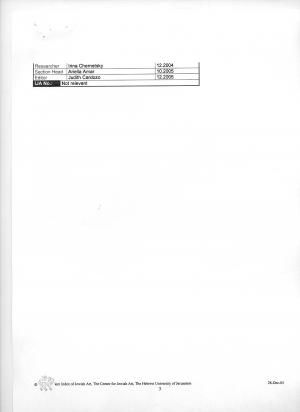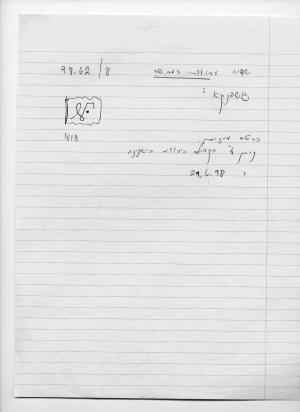Obj. ID: 5627
Sacred and Ritual Objects Dedicatory plaque, Ioannina, 1818

The shield-shaped dedicatory plaque is topped by a multifoil pointed arch and has three rounded lobes at its bottom. It bears a Hebrew inscription in the centre. The inscription is arranged in eleven lines and written in square, outlined letters that read:
"אל שדי/ הספר תורה והמפה והתכשיט הקדיש'' (הקדישם)/ היקר והנעלה כה"ר (כבוד הרב) מרדכי יצחקי יצ"ו (ישמרהו צורו ויחיהו) ל/ למנוחת בנו ידידו היקר ונעלה חנין/ יצחקי נ"ע (נוחו עדן) שנפטר בעיר פילבי (פלובדיב) יע"א (יבנה עירו אמן) ביום/ א' בחג הסוכות קע"ח יהי רצון מלפני/ אבינו שבשמים שתהא נפשו צרורה/ בצרור החיים עם הצדיקים בג"ע (בגן עדן) אמן/ והיה בבואו אל הקודש (מבוסס על שמות כח:כט; ויקרא י:יח; טז:כג; יחזקאל מד:כז) ביום מתן תורה/ פה ק"ק (קהל קדוש) ישן יע"א (יבנה עירו אמן)/ שנת התקע"ח."
"El Shadai (God Almighty), the Torah scroll, and the mappah (cloth) and the ornament were dedicated by the dear and the distinguished honourable Rabbi Mordekhai Y'izhaki, may his Rock protect and sustain him, for the repose of his son and friend, the dear and distinguished Hanin Y'izhaki, may he rest in Eden, who died in the city of Philibi (Plovdiv, Bulgaria; see: Remarks), may He build His city, amen, on the first day of the holiday of Sukkot (Feast of Tabernacles), (5)178 (5578 = 1818). May it be His will, Our Father in Heaven that his soul be bound up in the bond of life together with the righteous in the Garden of Eden, amen. And when it (the plaque) goeth into the Sanctuary (based on Ex. 28:29; Lev. 10:18, 16:23; Ezek. 44:27) (donated) on the day of giving of the Law (Shavu'ot; Pentecost), here in the Old Holy Congregation, may He build His city, amen, the year 5578 (10.06.1818)."
The bottom and the top of the plaque are decorated with floral motifs. The top depicts a bouquet of flowers mounted over a fleur-de-lis and a wreath of roses. The same wreath decorated with different flowers appears on the bottom.
The plaque is framed by a strip of dots, creating two scrolls at the top, and flanked by two serrated strips, bearing a linear motif. The scrolls enclose a flower within a crescent pattern.
sub-set tree:
objects known as shadai'ot (shadai'a in singular). The custom
of donating these plaques is common among the Greek Romaniot
communities. The name shadai'a is derived from God’s name,
"אל שדי" (El Shadai = God Almighty) which usually heads the
dedicatory inscription. The plaque is also called a "takhshit,"
namely an ornament, which adorns the Torah, a term often
inscribed on the plaques. This shadai'a is part of a larger group of
plaques, documented in several collections around the world, which together forms the most comprehensive collection of shadai'ot.
The dedication of silver plaques as sacred objects is unique to the Greek Romaniot communities. Some inscriptions do reveal that occasionally they were donated with other ritual objects, such as a Torah scroll, a parokhet, or a mappah. Yet, unlike the common custom in other communities, they were not attached to specific ritual objects at the time of the donation. When a large number of shadai'ot plaques were assembled in a synagogue they were sewn on to a parokhet in a reversed "Π" shape. Some were also attached to Torah case wrappers or belts, which were probably hung along the walls of the synagogue on different occasions.
Although the events mentioned in the dedicatory inscriptions occurred at different times, the plaques were consistently donated to the synagogue on special days in the Jewish Year. The three pilgrimage festivals (Passover, Shavu'ot, Sukkot) are common, as well as Rosh Ha-Shanah, Yom Kippur, Rosh Hodesh (the New Moon) and Sabbaths. Rarely does the date of the donation mentioned on the plaque indicate another day of the week.
The custom was practiced among the Romaniot communities of Arta, Ioannina, Previzia, and is still practiced in Trikala and Larissa. No differences were noticeable between the two congregations in Ioannina concerning shape, dedicatory formulas or names of donors. The only distinction between the Old and New Holy Congregations is the name of the synagogue (when it appears). Most contemporary shadai'ot from Trikala and Larissa differ from the others and are shaped as Stars of David enclosed within circles. Few of them maintain the early linguistic dedicatory formulas.
The shadai'ot are important historical documents, which reflect both the artistic and the cultural heritage of the Romaniot communities in Greece. Their importance goes beyond the art of sacred objects; this unique custom offers a fascinating window to the rich Greek Jewish culture in the past four hundred years.
1. Artist/ maker?
The hallmark consists of three Arabic letters: بمو (B M W)
set within a rectangular serrated frame.
Identification
The hallmark is unidentified and probably indicates
the artist's initials.
Remarks
According to the dedicatory inscription the object was produced in 1818, probably in Ioannina, which then was part of the Ottoman Empire.
- Amar, Ariella, and Irina Chernetsky. Shadai'ot: The Collection of the Jewish Museum of Greece.Jerusalem: The Center for Jewish Art, TheHebrewUniversity ofJerusalem, 2006. Internal publication.







